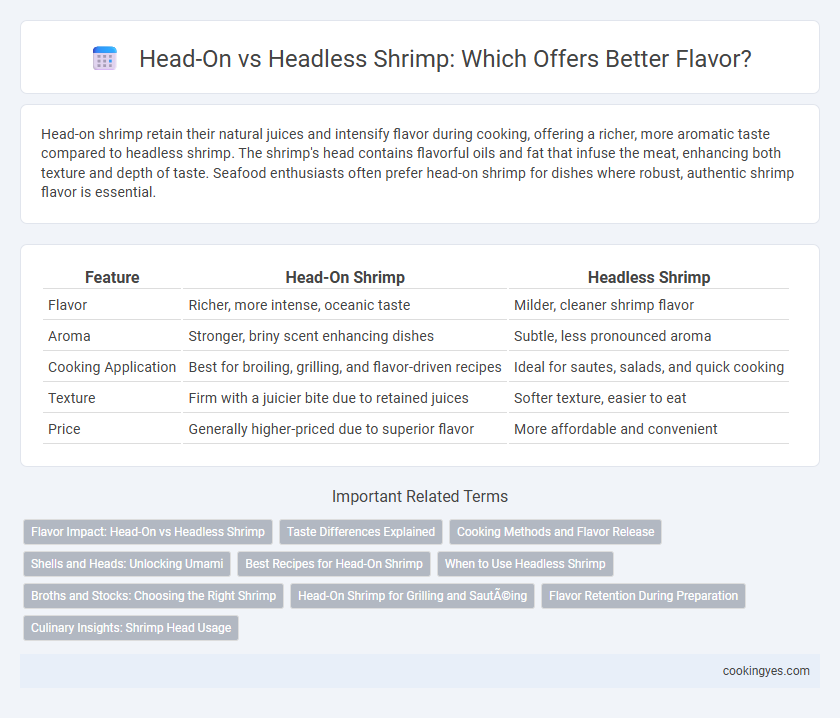Head-on shrimp retain their natural juices and intensify flavor during cooking, offering a richer, more aromatic taste compared to headless shrimp. The shrimp's head contains flavorful oils and fat that infuse the meat, enhancing both texture and depth of taste. Seafood enthusiasts often prefer head-on shrimp for dishes where robust, authentic shrimp flavor is essential.
Table of Comparison
| Feature | Head-On Shrimp | Headless Shrimp |
|---|---|---|
| Flavor | Richer, more intense, oceanic taste | Milder, cleaner shrimp flavor |
| Aroma | Stronger, briny scent enhancing dishes | Subtle, less pronounced aroma |
| Cooking Application | Best for broiling, grilling, and flavor-driven recipes | Ideal for sautes, salads, and quick cooking |
| Texture | Firm with a juicier bite due to retained juices | Softer texture, easier to eat |
| Price | Generally higher-priced due to superior flavor | More affordable and convenient |
Flavor Impact: Head-On vs Headless Shrimp
Head-on shrimp retain their shells and heads, which are rich in natural compounds that enhance umami flavor and provide a deeper, more complex taste during cooking. Cooking shrimp with the head intact allows the flavorful juices and aromas to infuse the flesh, resulting in a richer, more pronounced seafood essence compared to headless shrimp. Headless shrimp offer convenience but often sacrifice some intensity and depth of flavor that head-on shrimp naturally deliver.
Taste Differences Explained
Head-on shrimp retain their heads, which contain enzymes and compounds that infuse the meat with a richer, more intense flavor during cooking. Headless shrimp lack these natural flavor-enhancing components, resulting in a milder and less complex taste profile. Chefs often prefer head-on shrimp for dishes that benefit from deeper, seafood-forward flavors.
Cooking Methods and Flavor Release
Head-on shrimp retain the shell, head, and juices, which release rich, concentrated flavors during cooking methods like grilling and roasting, enhancing the overall taste profile. Headless shrimp offer convenience and quicker cooking but lack the depth of flavor infusion that comes from the shrimp's head and shell. Steaming or boiling head-on shrimp preserves their natural briny essence, making dishes more aromatic and flavorful compared to headless shrimp preparations.
Shells and Heads: Unlocking Umami
Shrimp shells and heads contain high levels of glutamates and nucleotides, natural compounds responsible for deep umami flavor, making head-on shrimp significantly richer in taste than headless varieties. Cooking shrimp with shells and heads intact releases more flavorful oils and enhances broth or sauce complexity through the infusion of savory compounds. Using head-on shrimp maximizes flavor extraction, elevating dishes with robust seafood essence unattainable with peeled counterparts.
Best Recipes for Head-On Shrimp
Head-on shrimp retain their natural juices and essential oils, enriching dishes with a deeper, more intense flavor compared to headless shrimp. Best recipes for head-on shrimp, such as grilled shrimp with garlic butter or spicy Cajun boil, highlight the enhanced umami and succulent texture that the heads contribute. Using head-on shrimp in recipes ensures a richer seafood experience, maximizing taste and aroma in every bite.
When to Use Headless Shrimp
Headless shrimp are ideal for recipes requiring quick cooking or where shrimp shells might interfere, such as salads, stir-fries, and shrimp cocktails. Removing the head reduces cooking time and creates a cleaner presentation, making them perfect for dishes where delicate flavors and ease of eating are prioritized. Use headless shrimp when you want to highlight the shrimp's natural sweetness without the intensity added by the shell and head.
Broths and Stocks: Choosing the Right Shrimp
Head-on shrimp contribute rich, umami-packed flavors to broths and stocks, as the shells and heads release concentrated aromatic compounds during simmering. Headless shrimp, while convenient and faster to prepare, lack the depth of taste provided by the shrimp heads and often result in a less robust broth. For optimal flavor extraction in seafood stocks, using head-on shrimp is preferred because the heads enhance the savory complexity and overall richness.
Head-On Shrimp for Grilling and Sautéing
Head-on shrimp retain their natural juices and shell oils, intensifying flavor during grilling and sauteing by locking in moisture and imparting a rich, briny taste. The heads contain enzymes and fats that release aromatic compounds when cooked, enhancing umami and depth in dishes. Choosing head-on shrimp for these cooking methods results in a more succulent texture and a robust, ocean-fresh flavor profile compared to headless shrimp.
Flavor Retention During Preparation
Head-on shrimp retain more natural briny juices and rich umami flavors due to the presence of the shell and head protecting delicate meat during cooking. The head contains flavor-rich compounds like astaxanthin and amino acids that infuse the shrimp, enhancing flavor depth. Headless shrimp tend to lose moisture and subtle taste nuances faster, resulting in less intense, less succulent dishes.
Culinary Insights: Shrimp Head Usage
Shrimp heads contain concentrated flavors and natural umami that enhance broths, sauces, and seafood dishes with richer taste and depth. Culinary experts often advocate using head-on shrimp to extract oils and aromatics that intensify overall flavor profiles in recipes like bisques and gumbo. Removing heads eliminates bitterness but sacrifices essential flavor compounds crucial for authentic shrimp-based cuisine.
Head-On vs Headless Shrimp for flavor Infographic

 cookingyes.com
cookingyes.com